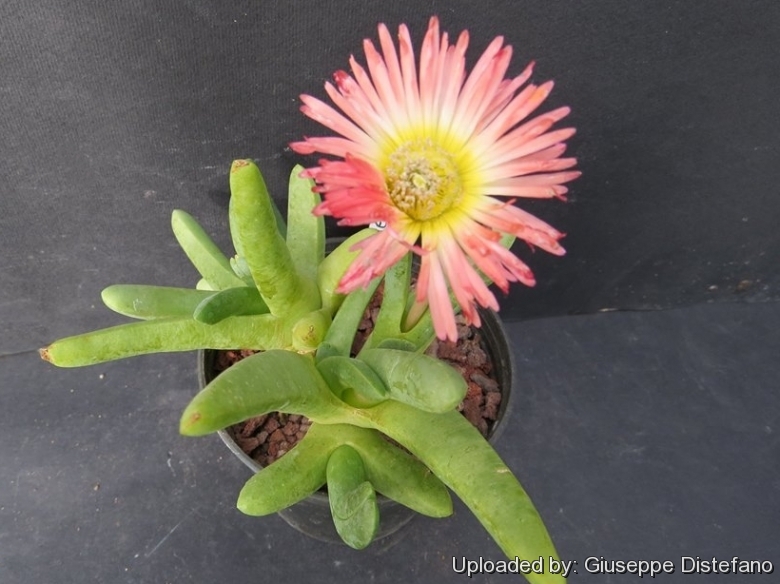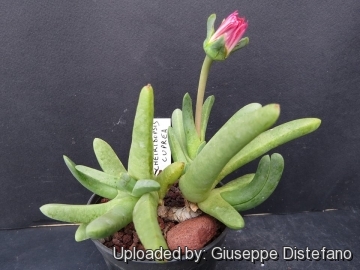




Your support is critical to our success.
Accepted Scientific Name: Cephalophyllum caespitosum H.E.K.Hartmann
Cact. Succ. J. Gr. Brit. 43: 100 1981 nom. nov.

Origin and Habitat: Vanrhynsdorp District, Western Cape, South Africa.
Habitat end ecology: Cephalophyllum caespitosumSN|26026]]SN|26026]] grows in open Succulent Karroo on quartz flats or in sandy loamy depressions togheter with species of the genera Argyroderma, Monilaria, Oophytum, and Dactylopsis. Precipitation 100-200 mm per annum mainly in winter (August).
Synonyms:
- Cephalophyllum caespitosum H.E.K.Hartmann
- Cheiridopsis cuprea (L. Bolus) N.E.Br.
- Mesembryanthemum cupreum L. Bolus
Description: Cephalophyllum caespitosumSN|11156]]SN|26026]] is a somewhat limp-leaved species with large flowers with many thin petals ranging in colour from salmon to coppery or magenta with paler centre.
Taxonomy: Cephalophyllum caespitosumSN|29964]]SN|26026]] H.Hartmann Cact. Succ. J. Gr. Brit. 43(4): 100 (1981), nom. nov. is the new name (replaced synonym) of Mesembryanthemum cupreumSN|26027]]SN|26027]] L.Bolus 1924 26028]SN|26028]] (L. Bolus) N.E.Br. 1926].
Habit: Densely caespitose, rarely compact, forming small clumps up to 12 cm across.
Leaves: Anisophyllous in the young, somewhat beak-shaped leaf-pair. Apically trigonous, upright or spreading, the leaf-tip is crowned by a small tooth (mucro), which can fall off on older leaves, pustule inconspicuous, 30-55 mm long, dark green, shiny due to few wax platelets on the surface.
Flowers: 18-60 mm in diameter, solitary and terminal, purple to whitish, orange/copper or cream, in addition, bright colours like purple and copper lose intensity and become lighter during
anthesis. Tepals 70-85. Stamens 140-170, filaments yellow to orange, anthers yellow to purple.
Blooming season: Winter. The flowers open mainly at midday and in the afternoon to attract insect pollinators. They last for a few days. Flowers will only open in bright sun. At night or during cloudy days, they remain closed. Flowering in habitat seems to occur towards the end of the rainy season (August), and fruits ripen during the following dry season.
Fruit: On procumbent, persisting peduncles, differing from the typical form of the genus by an erect outer rim of the covering membrane and narrow valve wings, 9-10 locules.
Seeds: Smooth, 0.6-1 mm long, 0.35-0.6 mm broad.
Chromosome number: 2n = 18, rarely 27
Note: Cephalophyllum caespitosum Hartmann nom. nov. is the replaced synonym of Mesembryanthemum cupreumSN|26027]]SN|26027]] L.Bolus (1924) as the epithet cupreum being preoccupied in Cephalophyllum by Cephalophyllum cupreum L. Bol., This species and Cephalophyllum spissumSN|26026]]SN|29964]] are often confused, both having been called "Cheiridopsis cupreaSN|26028]]SN|26028]]". C. caespitosum grows also sympatrically with Cephalophyllum parvibracteatumSN|26026]]SN|11156]], which never shows anisophylly, but can form dense cushions.
Bibliography: References and further reading
1) Klak, C. & Raimondo, D. 2006. Cephalophyllum caespitosum H.E.K.Hartmann. National Assessment: “Red List of South African Plants” version 2013.1. Accessed on 2014/01/31
2) Heidrun E. K. Hartmann “Notes on the genus Cephalophyllum* 3. The status of Cheiridopsis cuprea (L.Bol.) N.E.Br.” in: The Cactus and Succulent Journal of Great Britain Volume 43(4): 96-100 1981
3) Oliver, I.B. “Grow succulents.” Kirstenbosch Gardening Series. National Botanical Institute, Cape Town.
4) Smith, G.F., Chesselet, P., Van Jaarsveld, E.J., Hartmann, H., Hammer, S., Van Wyk, B-E., Burgoyne, P., Klak, C. & Hubert, K. “Mesembs of the world.” National Botanical Institute, Pretoria.1998.
5) Doreen Court “Succulent Flora of Southern Africa” CRC Press, 01/giu/2000
6) Heidrun E. K. Hartmann “Aizoaceae: A-E” Springer, 2001
7) Heidrun E. K. Hartmann: “Zur Biologie und Taxonomie des Cephalophyllum curto-phyllum-Komplexes (Mesembryanthemaceae). (Beitrage zur Gattung Cephalophyllum. IV).” In: Mitteilungen aus dem Institut für Allgemeine Botanik Hamburg. Volume 19, 141–163. 1984.
8) Gideon Smith u.a. (Hrsg.): “Mesembs of the World: Illustrated Guide to a Remarkable Succulent Group.” Briza Publications, 1998
9) Heidrun E. K. Hartmann: “Monographien der Subtribus Leipoldtiinae. VIII. Monographie der Gattung Cephalophyllum (Mesembryanthemaceae).” In: Mitteilungen aus dem Institut für Allgemeine Botanik Hamburg. Volume 22, 93–187 1988.
10) Heidrun E. K. Hartmann: “Notes on the genus Cephalophyllum: chromosome numbers in the genus Cephalophyllum N.E.Br. (Mesembryanthemaceae).” In: Cactus and succulent journal volume 58, Number 6, 263–266, 1986

Mesembryanthemum cupreum (Cephalophyllum caespitosum) Photo by: Giuseppe Distefano

Cephalophyllum caespitosum Bitterfontein, Western Cape, South Africa. (Cephalophyllum caespitosum) Photo by: Valentino Vallicelli
Cultivation and Propagation: Cephalophyllum caespitosumSN|26026]]SN|26026]] is most active in winter, but in favourable growing conditions it keeps going over the summer too and doesn't need particular care. In cultivation Cephalophyllum caespitosumSN|26026]]SN|26026]] seems to prefer a fairly dry rest in winter but grows whenever watered. In very dry warm regions these succulents make very impressive out door ground covers.
Soil: Requires good drainage as it it is prone to root rot. It can grows outdoor in sunny, dry, rock crevices (protection against winter wet is required) It can also be cultivated in alpine house, in poor, drained soil.
Fertilization: Feed it once during the growing season with a fertilizer specifically formulated for cactus succulents (poor in nitrogen), including all micro nutrients and trace elements diluted to ½ the strength recommended on the label. It thrives in poor soils and need a limited supplies of fertilizer to avoid the plants developing excess vegetation, which is easily attacked by fungal diseases.
Watering: They are not at all delicate and can take some water year-round. Water minimally in winter, only when the plant starts shrivelling, water more abundantly when they are growing in the spring, but let the soil dry between soaking. During summer, they still need some water eventhough they are somewhat dormant. If grown in a container, bottom watering by immersing the container is recommended. It must have very dry atmosphere.
Light: It needs a bright sunny or light shade exposure in winter, but keep cool and partially shaded in summer.
Hardiness: It prefer a very bright situation and require a minimum temperature 5°C, but can be cool to cold and dry in the dead of winter. The earlier in the year they are planted, the better the chances for winter survival. True with many of the Mesembryanthemaceae.
Maintenance: Pinch off spent flowers to encourage more blooms.
Uses: This water-wise garden plan is an excellent plant for container growing. It always looks good and stays small. It look fine in a cold greenhouse and frame or outdoor in a rockery.
Pests & diseases: Cephalophyllum caespitosumSN|26026]]SN|26026]] may be attractive to a variety of insects, but plants in good condition should be nearly pest-free, particularly if they are grown in a mineral potting-mix, with good exposure and ventilation. Nonetheless, there are several pests to watch for:
- Red spiders: Red spiders may be effectively rubbed up by misting the plants every day.
- Mealy bugs: Mealy bugs occasionally develop aerial into the new leaves and flowers with disfiguring results, but the worst types develop underground on the roots and are invisible except by their effects.
- Sciara Flies: Sciara flies are one of the major problems for seedlings. It is a good practice to mulch your seedlings with a layer of grit, which will strongly discourage the flies.
- Scales, thrips and aphids: This insects are rarely a problem.
- Rot: Rot it is only a minor problem with mesembs if the plants are watered and “aired” correctly. If they are not, fungicides won't help all that much.
Propagation: It is very quick and easy to start from seed or cuttings. Seeds germinate in 7-14 days at 21°C in spring. To make a cutting twist off a branch with at least a part of roots and permit it to dry out a couple of days, lay it on the soil and insert the stem end partially into the soil. Try to keep the cutting somewhat upright so that the roots are able to grow downward. To enhance rooting success use a rooting hormone powder.
| Your Actions | |
|---|---|
| Back to Mesembryanthemum index | |
| Back to Aizoaceae index | |
 |
Back to Succulents Encyclopedia index |
Privacy stantement - Terms and conditions - How to cite - About us - Feedback - Donate




